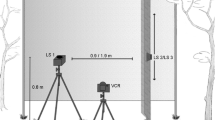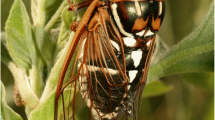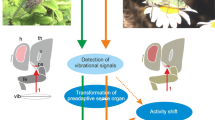Abstract
Gravid females of Ormia ochracealocate their hosts by homing on their hosts' calling songs. At Gainesville, Florida, O. ochraceafemales were attracted in greatest numbers to broadcast sounds that simulated the calling song of Gryllus rubens.Other candidate hosts and the attractiveness of their songs relative to the simultaneous song of G. rubenswere G. fultoni(9%), G. integer(4%), G. firmus(3%), Orocharis luteolira(1%), Scapteriscus borellii(1%), and S. vicinus(0%). The response of female O. ochraceato simulated G. rubenssongs that have different pulse rates changes with temperature in parallel with temperature-induced changes in the pulse rate of natural songs. Speaker stations ≤ 16 m apart in an apparently uniform environment produced strikingly different fly counts (e.g., 852 and 2163). The song of G. rubensat 21 °C approximates a continuous sequence of 4.6-kHz pulses at a rate of 45 s −1 and with a duty cycle of 50%. When two of these parameters were held constant and the third systematically varied in steps of 0.4kHz, 10s −1,and 10–20%, maximum attraction occurred at 4.4 kHz, 45 s −1,and 20–80%. Omitting as many as half the pulses in a rubenssimulation (e.g., 1, 2, 4, or 16 pulses followed by an equivalent silence, and repeat) did not significantly reduce the counts of O. ochracea,proving that chirping (producing pulses in brief groups) is no safeguard from call-seeking O. ochracea.Phase shifting of pulses in successive chirps sometimes decreased fly counts. When songs were first broadcast, flies came within seconds. Flies that landed at sound often stayed for minutes, even when the sound was turned off.
Similar content being viewed by others
References
Burk, T. (1982). Evolutionary significance of predation on sexually signalling males.Fla. Entomol. 65: 90–104.
Cade, W. (1975). Acoustically orienting parasitoids: Fly phonotaxis to cricket song.Science 190: 1312–1313.
Cade, W. (1979). The evolution of alternative male reproductive strategies in field crickets. In Blum, M. S., and Blum, N. A. (eds.),Sexual Selection and Reproductive Competition in Insects, Academic Press, New York.
Cade, W. H. (1981). Field cricket spacing, and the phonotaxis of crickets and parasitoid flies to clumped and isolated cricket songs.Z. Tierpsychol. 55: 365–375.
Doherty, J. A., and Callos, J. D. (1991). Acoustic communication in the trilling field cricket,Gryllus rubens (Orthoptera: Gryllidae).J. Insect Behav. 4: 67–82.
Doherty, J. A., and Hoy, R. (1985). Communication in insects. III. The auditory behavior of crickets: Some views of genetic coupling, song recognition, and predator detection.Q. Rev. Biol. 60: 457–472.
Forrest, T. G. (1983). Phonotaxis and calling in Puerto Rican mole crickets (Orthoptera: Gryllotalpidae).Ann. Entomol. Soc. Am. 76: 797–799.
Forrest, T. G., and Green, D. M. (1991). Sexual selection and female choice in mole crickets(Scapteriscus: Gryllotalpidae): Modelling the effects of intensity and male spacing.Bioacoustics 3: 93–109.
Fowler, H. G. (1987). Field behavior ofEuphasiopteryx depleta (Diptera: Tachinidae): Phonotactically orienting parasitoids of mole crickets (Orthoptera: Gryllotalpidae:Scapteriscus).J. N. Y. Entomol. Soc. 95: 474–480.
Fowler, H. G., and Kochalka, J. N. (1985). New records ofEuphasiopteryx depleta (Diptera: Tachinidae) from Paraguay: Attraction to broadcast calls ofScapteriscus acletus (Orthoptera: Gryllotalpidae).Fla. Entomol. 68: 225–226.
Fowler, H. G., and Mesa, A. (1987). Alternate orthopteran hosts(Anurogryllus sp.) ofEuphasiopteryx depleta (Diptera: Tachinidae).Fla. Entomol. 70: 408–409.
Lakes-Harlan, R., and Heller, K.-G. (1992). Ultrasound-sensitive ears in a parasitoid fly.Naturwissenschaften 79: 224–226.
Mangold, J. R. (1978). Attraction ofEuphasiopteryx ochracea, Corethrella sp. and gryllids to broadcast songs of the southern mole cricket.Fla. Entomol. 61: 57–61.
Robert, D., Amoroso, J., and Hoy, R. R. (1992). The evolutionary convergence of hearing in a parasitoid and its cricket host.Science 258: 1135–1137.
Ulagaraj, S. M., and Walker, T. J. (1975). Response of flying mole crickets to three parameters of synthetic songs broadcast outdoors.Nature 253: 530–532.
Walker, T. J. (1962). Factors responsible for intraspecific variation in the calling songs of crickets.Evolution 16: 407–428.
Walker, T. J. (1973). Systematics and acoustic behavior of United States and Caribbean short-tailed crickets (Orthoptera: Gryllidae:Anurogryllus).Ann. Entomol. Soc. Am. 66: 1269–1277.
Walker, T. J. (1974).Gryllus ovisopis n.sp.: A taciturn cricket with a life cycle suggesting allochronic speciation.Fla. Entomol. 57: 13–22.
Walker, T. J. (1986). Monitoring the flights of field crickets (Gryllus spp.) and a tachinid fly (Euphasiopteryx ochracea) in north Florida.Fla. Entomol. 69: 678–685.
Walker, T. J. (1987).Euphasiopteryx ochracea: Phonotactic responses to broadcasts of synthetic sounds in the field.Annu. Rep. Mole Cricket Res. 9: 153–161. (Documents, University of Florida Libraries, Gainesville.)
Walker, T. J. (1988). Acoustic traps for agriculturally important insects.Fla. Entomol. 71: 484–492.
Walker, T. J. (1989). A live trap for monitoringEuphasiopteryx spp. and tests withE. ochracea (Diptera: Tachinidae).Fla. Entomol. 72: 314–319.
Walker, T. J. (1990). Mans's artificial cricket: An economical, versatile sound synthesizer.Annu. Rep. Mole Cricket Res. 12: 6–10. (Documents, University of Florida Libraries, Gainesville.)
Walker, T. J., and Forrest, T. G. (1989). Mole cricket phonotaxis: Effects of intensity of synthetic calling song (Orthoptera: Gryllotalpidae:Scapteriscus acletus).Fla. Entomol. 72: 655–659.
Walker, T. J., and Wineriter, S. A. (1991). Hosts of a phonotactic parasitoid and levels of parasitism (Diptera: Tachinidae:Ormia ochracea).Fla. Entomol. 74: 554–559.
Walker, T. J., Brandt, J. F., and Dew, D. (1970). Sound-synchronized, ultra-high-speed photography: A method for studying stridulation in crickets and katydids (Orthoptera).Ann. Entomol. Soc. Am. 63: 910–912.
Zar, J. H. (1984).Biostatistical Analysis, 2nd ed., Prentice-Hall, Englewood Cliffs, NJ.
Author information
Authors and Affiliations
Rights and permissions
About this article
Cite this article
Walker, T.J. Phonotaxis in femaleOrmia ochracea (Diptera: Tachinidae), a parasitoid of field crickets. J Insect Behav 6, 389–410 (1993). https://doi.org/10.1007/BF01048119
Accepted:
Issue Date:
DOI: https://doi.org/10.1007/BF01048119




